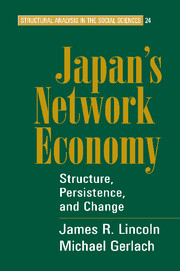Book contents
- Frontmatter
- Contents
- List of Figures
- List of Tables
- Acknowledgments
- Introduction
- 1 The Structural Analysis of the Network Economy
- 2 The Origins of Japanese Network Structures
- 3 The Evolution of a Corporate Network: A Longitudinal Network Analysis of 259 Large Firms
- 4 Exchange and Control: Explaining Corporate Ties: A Longitudinal Dyad Analysis
- 5 Intervention and Redistribution: How Keiretsu Networks Shape Corporate Performance
- 6 Japan's Next-Generation Industrial Architecture
- Bibliography
- Index
- References
Bibliography
Published online by Cambridge University Press: 05 April 2010
- Frontmatter
- Contents
- List of Figures
- List of Tables
- Acknowledgments
- Introduction
- 1 The Structural Analysis of the Network Economy
- 2 The Origins of Japanese Network Structures
- 3 The Evolution of a Corporate Network: A Longitudinal Network Analysis of 259 Large Firms
- 4 Exchange and Control: Explaining Corporate Ties: A Longitudinal Dyad Analysis
- 5 Intervention and Redistribution: How Keiretsu Networks Shape Corporate Performance
- 6 Japan's Next-Generation Industrial Architecture
- Bibliography
- Index
- References
- Type
- Chapter
- Information
- Japan's Network EconomyStructure, Persistence, and Change, pp. 379 - 400Publisher: Cambridge University PressPrint publication year: 2004

